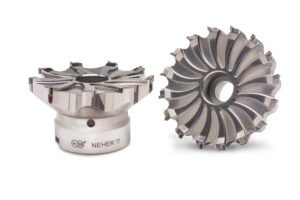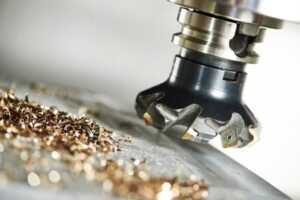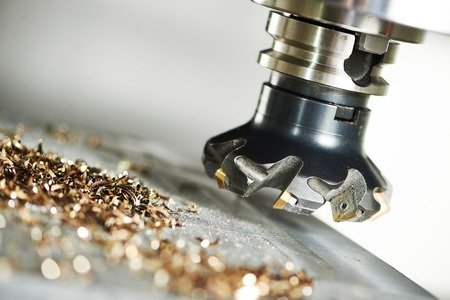Everything You Need to Know about Milling Cutters in CNC Machining
Milling cutters are rotary cutting tools used in machining processes to remove material from a workpiece. They feature multiple cutting edges, known as teeth or flutes, that efficiently shear away material as the cutter rotates. These versatile tools are crucial in various industries, including manufacturing, automotive, aerospace, and more.
Milling cutters come in various shapes and sizes to accommodate different machining tasks, such as end mills, face mills, ball nose cutters, and slot drills. They play a vital role in shaping, profiling, and finishing workpieces with precision and efficiency.
In this article, MaTec Vietnam will explore in detail about Milling Cutters and distinguish types of Milling Cutters
Understanding Milling Cutters
Milling cutters play a pivotal role in CNC machining, offering a diverse range of shapes, sizes, and materials tailored for specific milling tasks. Here’s a breakdown of their key components:
Body
The central part housing cutting edges, typically made from high-speed steel, cobalt steel, carbide-tipped, or solid carbide, with diameters ranging from two to four inches.
Flutes
Grooves or channels in the cutter body, facilitating chip removal during cutting. More flutes yield smoother cuts but slower feed rates, while fewer flutes allow for rougher cuts but higher feed rates.
Cutting Edges or Teeth
Responsible for slicing through the workpiece, these edges come in various geometries – straight, helical, or staggered – influencing cutter performance and functionality.
Shank
The section is held in the milling machine’s tool holder, crucial for stable rotation and vibration-free operation, requiring robust and precisely crafted construction.
Milling cutters embody versatility and precision, essential for diverse machining applications across industries.

Distinguish Types of Milling Cutters
Milling cutters are available in diverse shapes and sizes, each tailored for specific milling tasks. Selection of the cutter depends on both the material being milled and the operation at hand.
End Mills
Among the most widely used milling cutters, end mills derive their name from their ability to cut from both the end and the sides. They excel in slotting, profiling, and plunging tasks. End mills boast a versatile design, enabling the creation of various shapes to suit numerous applications.
There exists a range of end mills, such as:
- Square end mills: Ideal for crafting flat-bottomed grooves and slots.
- Ball end mills: Suited for milling rounded slots or intricate contours.
- Roughing end mills: Designed with serrations to efficiently eliminate substantial material volumes.
Face Mills
Face mills are utilized for facing operations aimed at producing flat or squared surfaces. Their cutting edges are positioned along the outer perimeter of the tool, typically larger than the width of the workpiece.
This setup enables a substantial surface area to be processed in a single pass. Face mills commonly incorporate indexable carbide inserts in diverse sizes, shapes, and grades, catering to various materials and finishing requirements.
Slab Mills
Slab mills are specifically crafted for wide, flat surface cutting, known as slabbing, and for general-purpose machining tasks. Their teeth are positioned along the outer edge of the cylinder, enabling the tool to function effectively at high speeds and efficiently remove material across extensive surface areas. These mills find frequent application in heavy-duty operations requiring rapid removal of substantial material volumes.
Fly Cutters
ly cutters represent a category of milling cutters featuring a single cutting blade. These cutters are renowned for producing large, smooth arcs, ideal for achieving highly smooth and accurate surface finishes.
The solitary blade of the fly cutter, positioned at an angle to the workpiece, executes cuts with a slicing motion, resulting in a polished surface. Moreover, the cut width is adaptable, empowering users to tailor the cutter size to the workpiece.
Form Milling Cutters
Form milling cutters are unique tools engineered for milling precise shapes into a workpiece. They have the capability to carve curves and contours or fabricate intricate shapes like dovetails, T-slots, and other specialized grooves or indents.
These cutters are frequently customized to fulfill the demands of particular tasks, rendering them indispensable for bespoke projects.
Hollow Mills
Hollow mills, akin in appearance to drill bits, are cutting tools employed to bore holes into workpiece surfaces or expand existing apertures. Functioning by removing material from the interior of the workpiece, they yield a hollowed-out region. Frequently utilized alongside other milling cutters, they contribute to crafting intricate shapes and features.
Plasma Cutter Miller: A Modern Marvel
Revolutionizing the milling industry, the plasma cutter miller stands out as a versatile and highly efficient tool, admired for its precision and effectiveness.
Unlike traditional milling cutters, this innovation harnesses a high-velocity jet of ionized gas or plasma to slice through electrically conductive materials. It shines in scenarios demanding utmost accuracy or when materials resist conventional milling methods.
The process kicks off with the formation of an electric arc within the gas, typically air, channeled through a small nozzle orifice in the torch. This arc ionizes the gas, generating a concentrated, heated, and precisely directed plasma beam that swiftly melts away the material.
The prowess of the plasma cutter miller can be summarized as follows:
- Speed and Efficiency: Plasma cutters outpace traditional milling tools, boasting cutting speeds of up to 500 inches per minute.
- Precision: Advancements in technology enable modern plasma cutters to achieve cuts with an accuracy of up to ±0.01 inches, rivaling that of laser cutters.
- Versatility: Capable of slicing through a wide array of metals, including steel, stainless steel, aluminum, brass, and copper.
- Ease of Use: Plasma cutters demand less expertise to operate compared to traditional milling equipment, often equipped with built-in safety measures.

CNC Milling Cutters: Precision Perfected
In the realm of milling technology, CNC milling cutters stand as a hallmark advancement. Driven by Computer Numerical Control (CNC) systems, these cutters deliver unparalleled accuracy and reliability in machining operations.
Harnessing CNC technology, milling cutters maneuver through three-dimensional space with exceptional precision, enabling the creation of intricate shapes and designs that were once unattainable via manual methods. Widely deployed in production environments demanding consistent quality across numerous components, such as in automotive and aerospace sectors, CNC milling cutters ensure uniformity and precision at scale.
Key advantages of CNC milling cutters encompass:
- Consistency: The computer-driven process ensures reliable, repeatable precision.
- Speed: CNC milling machines often operate at accelerated speeds compared to manual counterparts.
- Complexity: Capable of crafting intricate shapes and intricate designs with ease.
- Automation: Reduced reliance on manual intervention minimizes the likelihood of human error, enhancing efficiency and reliability.

Conclusion
Overall, Milling cutters play a pivotal role in CNC machining, offering versatility, precision, and efficiency in shaping and machining workpieces. From end mills and face mills to slab mills and specialized tools like fly cutters and form milling cutters, each type serves a unique purpose in achieving desired machining outcomes.
We take pride in being a leading provider of CNC Milling services and can become a reliable partner for you. Contact MaTec Vietnam today to receive the best quote for CNC Milling services.

